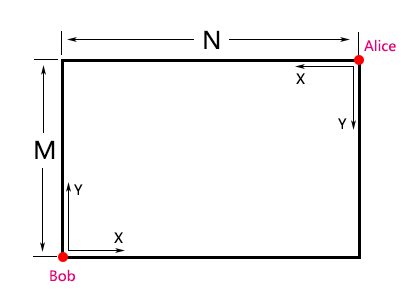Alice and Bob
Time Limit: 2000/1000 MS (Java/Others) Memory Limit: 32768/32768 K (Java/Others)
Total Submission(s): 155 Accepted Submission(s): 110
Now, Bob in the lower left corner of the Square, Alice in the upper right corner of the the Square. Bob regards the lower left corner as the origin of coordinates, rightward for positive direction of axis X, upward for positive direction of axis Y. Alice regards
the upper right corner as the origin of coordinates, leftward for positive direction of axis X, downward for positive direction of axis Y. Assuming that Square is a rectangular, length and width size is N * M. As shown in the figure:

Bob and Alice with their own definition of the coordinate system respectively, went to the coordinate point (x, y). Can they meet with each other ?
Note: Bob and Alice before reaching its destination, can not see each other because of some factors (such as buildings, time poor).
10 10 5 5 10 10 6 6
YES NO
#include<algorithm>
#include<iostream>
#include<string.h>
#include<stdio.h>
using namespace std;
const int INF=0x3f3f3f3f;
const int maxn=100010;
typedef long long ll;
int main()
{
int n,m,x,y;
while(~scanf("%d%d%d%d",&n,&m,&x,&y))
{
if(x==n-x&&y==m-y)
printf("YES\n");
else
printf("NO\n");
}
return 0;
}
Bob and math problem
Time Limit: 2000/1000 MS (Java/Others) Memory Limit: 32768/32768 K (Java/Others)
Total Submission(s): 456 Accepted Submission(s): 169
There are N Digits, each digit is between 0 and 9. You need to use this N Digits to constitute an Integer.
This Integer needs to satisfy the following conditions:
- 1. must be an odd Integer.
- 2. there is no leading zero.
- 3. find the biggest one which is satisfied 1, 2.
Example:
There are three Digits: 0, 1, 3. It can constitute six number of Integers. Only "301", "103" is legal, while "130", "310", "013", "031" is illegal. The biggest one of odd Integer is "301".
Each case starts with a line containing an integer N ( 1 <= N <= 100 ).
The second line contains N Digits which indicate the digit $a_1, a_2, a_3, \cdots, a_n. ( 0 \leq a_i \leq 9)$.
3 0 1 3 3 5 4 2 3 2 4 6
301 425 -1
题意:
#include<algorithm>
#include<iostream>
#include<string.h>
#include<stdio.h>
using namespace std;
const int INF=0x3f3f3f3f;
const int maxn=100010;
typedef long long ll;
int arr[150],brr[150];
int main()
{
int n,i,p,ct;
while(~scanf("%d",&n))
{
ct=0,p=-1;
for(i=0;i<n;i++)
{
scanf("%d",&arr[i]);
if(arr[i]&1)
{
if(p==-1||arr[i]<arr[p])
p=i;
}
}
if(p==-1)
{
printf("-1\n");
continue;
}
for(i=0;i<n;i++)
if(i!=p)
brr[ct++]=arr[i];
sort(brr,brr+ct);
if(ct&&brr[ct-1]==0)
{
printf("-1\n");
continue;
}
for(i=ct-1;i>=0;i--)
printf("%d",brr[i]);
printf("%d\n",arr[p]);
}
return 0;
}
Boring count
Time Limit: 2000/1000 MS (Java/Others) Memory Limit: 32768/32768 K (Java/Others)
Total Submission(s): 250 Accepted Submission(s): 98
For each case, the first line contains a string which only consist of lowercase letters. The second line contains an integer K.
[Technical Specification]
1<=T<= 100
1 <= the length of S <= 100000
1 <= K <= 100000
3 abc 1 abcabc 1 abcabc 2
6 15 21
题意:
#include<algorithm>
#include<iostream>
#include<string.h>
#include<stdio.h>
using namespace std;
const int INF=0x3f3f3f3f;
const int maxn=100002;
typedef long long ll;
char txt[maxn];
int vis[27];
ll ans=0;
int main()
{
int t,n,k,le,ri,p;
scanf("%d",&t);
while(t--)
{
scanf("%s%d",txt,&k);
n=strlen(txt);
ans=le=ri=0;
memset(vis,0,sizeof vis);
p=-1;
while(ri<=n)
{
if(p==-1)
{
vis[txt[ri]-'a']++;
if(vis[txt[ri]-'a']>k)
p=ri;
else if(ri<n)
ans+=ri-le+1;
ri++;
}
else
{
vis[txt[le]-'a']--;
if(txt[le]==txt[p])
p=-1,ans+=ri-le-1;
le++;
}
}
printf("%I64d\n",ans);
}
return 0;
}
Argestes and Sequence
Time Limit: 5000/2500 MS (Java/Others) Memory Limit: 32768/32768 K (Java/Others)
Total Submission(s): 192 Accepted Submission(s): 44
on the sequence.An operation can be one of the following:
S X Y: you should set the value of a[x] to y(in other words perform an assignment a[x]=y).
Q L R D P: among [L, R], L and R are the index of the sequence, how many numbers that the Dth digit of the numbers is P.
Note: The 1st digit of a number is the least significant digit.
For each case, the first line contains two numbers N and M.The second line contains N integers, separated by space: a[1],a[2],...,a[n]—initial value of array elements.
Each of the next M lines begins with a character type.
If type==S,there will be two integers more in the line: X,Y.
If type==Q,there will be four integers more in the line: L R D P.
[Technical Specification]
1<=T<= 50
1<=N, M<=100000
0<=a[i]<=$2^{31}$ - 1
1<=X<=N
0<=Y<=$2^{31}$ - 1
1<=L<=R<=N
1<=D<=10
0<=P<=9
1 5 7 10 11 12 13 14 Q 1 5 2 1 Q 1 5 1 0 Q 1 5 1 1 Q 1 5 3 0 Q 1 5 3 1 S 1 100 Q 1 5 3 1
5 1 1 5 0 1
题意:
看到这题。喜出望外。今天是可以ak的节奏啊。(不知道1002会挂。。--||)。感觉典型线段树的应用。每个节点一个数组val[rt][i][j]。表示节点代表的区间里第i个数字为j的有多少个。然后欢快的写完了。写完编译运行一次通过。无任何错误和警告测样例完全正确!然后愉快的交了。然后就mle了。。。当时就傻了。一看题目内存限制。晕。居然有数据结构题目卡内存的。然后想了下树状数组开1e7空间就算是short也超了,但是想到了离线处理每一位的修改和询问。但这时已经20:20。依稀的记得20:30就要开hack了。就放弃了挣扎了。后来醒悟后还是没时间改了。虽然正解有我说的离线处理。但是总觉得还是蛮麻烦的就用分块写了。就是分成sqrt(n)块。块内直接暴力。块间利用整块信息维护快速算出答案。时间复杂度O(n*sqrt(n))。写完一交居然rank1.估计O(10*n*log(n))的做法常数太大了。
#include<algorithm>
#include<iostream>
#include<string.h>
#include<stdio.h>
#include<math.h>
using namespace std;
const int INF=0x3f3f3f3f;
const int maxn=100003;
typedef long long ll;
#define lson L,mid,ls
#define rson mid+1,R,rs
int val[maxn][11],da[400][11][10],x;
int main()
{
int t,n,m,i,j,le,ri,d,p,x,y,bk,ans,st,ed,lim;
char cmd[10];
scanf("%d",&t);
while(t--)
{
scanf("%d%d",&n,&m);
bk=ceil(sqrt(1.0*n));
memset(da,0,sizeof da);
memset(val,0,sizeof val);
for(i=1;i<=n;i++)
{
scanf("%d",&x);
for(j=1;j<=10;j++)
{
val[i][j]=x%10;
x/=10;
}
p=(i-1)/bk;
for(j=1;j<=10;j++)
da[p][j][val[i][j]]++;
}
for(i=0;i<m;i++)
{
scanf("%s",cmd);
if(cmd[0]=='Q')
{
scanf("%d%d%d%d",&le,&ri,&d,&p);
ans=0;
st=(le-1)/bk;
ed=(ri-1)/bk;
if(ed-st<=1)
{
for(j=le;j<=ri;j++)
if(val[j][d]==p)
ans++;
}
else
{
lim=(st+1)*bk;
for(j=le;j<=lim;j++)
if(val[j][d]==p)
ans++;
lim=ed*bk+1;
for(j=lim;j<=ri;j++)
if(val[j][d]==p)
ans++;
for(j=st+1;j<ed;j++)
ans+=da[j][d][p];
}
printf("%d\n",ans);
}
else
{
scanf("%d%d",&x,&y);
p=(x-1)/bk;
for(j=1;j<=10;j++)
{
if(y%10!=val[x][j])
{
da[p][j][val[x][j]]--;
val[x][j]=y%10;
da[p][j][val[x][j]]++;
}
y/=10;
}
}
}
}
return 0;
}